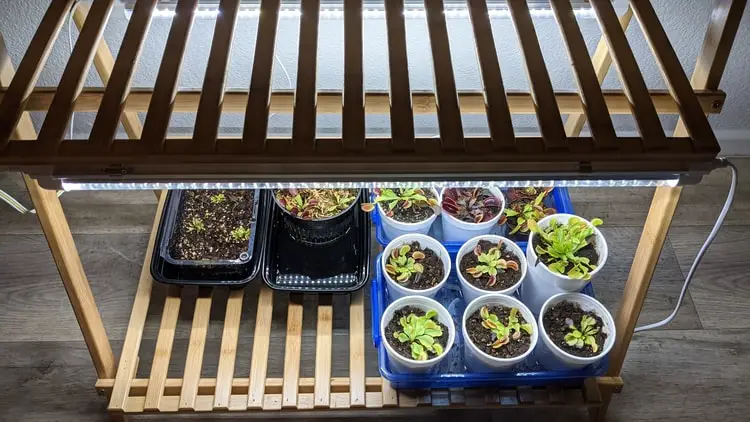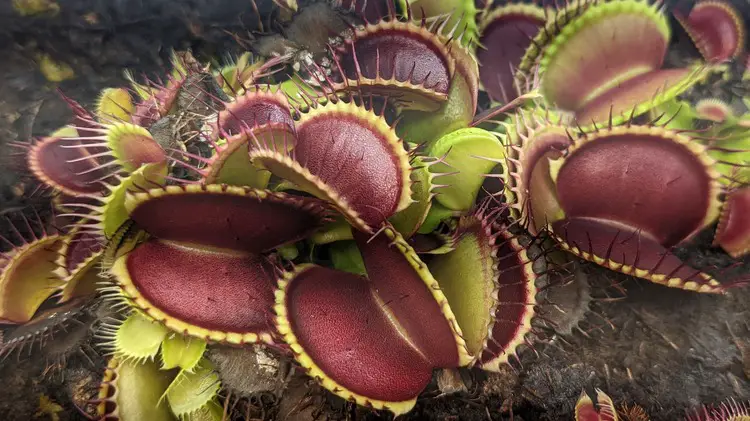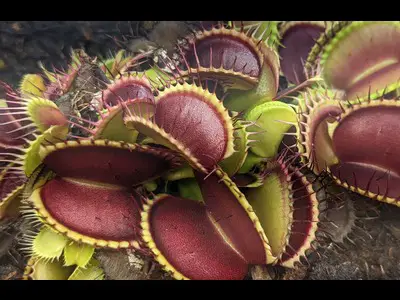Giving Venus flytraps enough lighting is critical to keep them alive and healthy. They are exposed to many hours of direct sunlight in their natural habitat, often over 12 hours in the growing season. When growing Venus flytraps at home, you must try replicating the high lighting conditions.
As a general rule providing over 12 hours of direct sunlight is optimal for Venus flytraps. The minimum recommended amount is 4-6 hours of direct sunlight. Venus flytraps can be grown indoors or outdoors as long as they receive enough light.
Growing Venus flytraps indoors is possible but a lot more challenging due to the need for artificial lighting. If you live in a sunny area, growing your Venus flytrap outdoors is your best bet!
I have grown venus flytraps outdoors and indoors for over five years and I can assure you: mastering the lighting setup is critical to growing carnivorous plants. In this article, I will share with you exactly how much light to give your Venus flytraps whether it is inside your home, on a windowsill, or outdoors 🙂
Venus Flytrap Outdoor Sunlight Requirements
Growing Venus flytraps outdoors is very beneficial for many reasons: airflow, plenty of bugs, seasonal temperature changes, and most importantly: natural lights! Sunlight is the best type of lighting you can provide to your plants.
For best results, grow Venus Flytraps under direct sunlight. Over 10 hours of daily sunlight are optimal for Venus flytraps. The minimum recommended daily hours of sunlight is 4 to 6 hours of direct sunlight.
Periods of partial shade throughout the day are acceptable as long as your plant has access to enough direct sunlight.
The more hours of sunlight, the better. There is really no limit to the lighting you should provide. When Venus flytraps grow under strong direct sunlight they grow rapidly, develop beautiful colors, and often divide and replicate, creating more and more traps.
Acclimation:
Before introducing a new plant to direct sunlight or increasing the amount of lighting, make sure to go through an inclination period. Slowly introduce your plant to more lighting by transitioning from partial shade to direct sunlight. Add 1-2 hours of direct sunlight per week until you get to complete direct sunlight.
Introducing new plants to direct sunlight right away can burn them or take them into shock. Venus flytraps love direct sunlight, but abrupt changes can harm them.
Temperature Considerations:
Venus flytraps have no issues withstanding hot temperatures as long as the soil is properly watered (you can find more information on watering here!) However, once the temperatures rise over 100F, your plant could be at risk of drying out or burning. A way to prevent harmful heat exposure is to use pots made of good insulation materials (plastic, styrofoam), use4 a shade cloth when temperatures rise above 110F, and keep your plants in a tray with water.
Venus Flytrap Indoor Lighting Requirements- Artificial Lighting Setup
Venus flytrap can grow indoors; however, providing enough indoor lighting can be challenging and expensive. In this section, I share my method and setup elements to grow venus flytraps indoors successfully and under a friendly budget.
First of all, if you have the chance to grow your Venus flytrap outdoors. Please do it. It is a lot easier 🙂
But if you don’t have that option… this is the way to do it:
When growing Venus flytraps indoors, first try to find a spot in your home that might have some access to natural light. Sunlight is very strong, and it’s free, so any would be very helpful to grow your Venus flytrap.
Artificial Lighting Venus Flytrap
As a general rule, Venus flytraps can remain healthy if exposed to more than 6 hours of artificial lighting. For optimal results, provide over 10 hours of artificial lights with LEDs or fluorescent bulbs of at least 1500 lumens.

Since artificial lighting can be a lot less effective than sunlight, you should aim to provide light for very long periods. You can run your lights for 16 hours; Venus flytraps will benefit from the extended exposure. I have used this small LED plant light to grow some of my Venus flytraps, and they are doing great. For multiple plants, you can employ these light fixtures: T8 LED light strips (6500k Cool White): https://amzn.to/3uWoeh2. Here is a picture of some of my Venus flytraps growing under these lights:

When growing Venus flytraps inside your home, consider buying T8 high-output fluorescent or LED lights of cool colors. The optimal temperature is 6500K.
The benefit of using LEDs for Venus flytraps is that they remain cold and are not a heat hazard. Also, they are more energy efficient than fluorescent lights. So, you can place them very close to your plant. I place them 10-15 inches away from the light source but feel free to experiment with the distance. Overall, you want your plant to be close to the light.
In this article, I explain in detail how to select artificial lights for your plants. Check it out for recommendations. It includes options for advance growers and for newbies, and also varied budget options that fit all.
There are also some scenarios where Venus flytraps can grow with a combination of sunlight and artificial lighting, like growing them on window sills or a sunny porch. If you believe your Venus flytrap is not getting enough light, you can always add artificial lighting to supplement.
In this video, I explain the basics of how to grow venus flytraps indoors and the lighting considerations plus growing tips 😉
remember that besides the lighting, there are other considerations you must address when growing Venus flytraps indoors: moisture, temperature, dormancy, etc…
Venus Flytrap Lighting in Windowsill
Windowsills can be great places to grow venus flytraps as long as they are bright enough. As a general rule south-facing windows get the most sun, however, the lighting can vary depending on your specific home so don’t follow that rule blindly.
Assess the windowsills in your home and choose one that provides at least 4 hours of direct sunlight. The more direct sunlight the better, but 4 hours is the bare minimum. Also, indirect sunlight also helps, but it should just be a supplement not the only source of lighting. For best results use a windowsill that opens so your plant can have access to bugs and continuous airflow.
Make sure to check for the temperature in the windowsill area. The glass in windows can sometimes act as a magnifying glass and heat up the area. Extreme heat can burn your plant, so make sure you check that first!
If none of your windowsills can provide enough light, consider using a combination of artificial and natural light. This small LED plant light I shared before had a clip that can easily attach to windowsills. I would suggest to provide at least 6 hours of artificial light as a supplement to sunlight.
5 Signs Your Venus Flytraps Needs More Light
These are some clear signs your Venus flytrap is not receiving enough light and might be dying:
Droopy Venus Flytrap: Your Venus flytrap is looping droopy and down. Not enough water or lighting can make your plant wilt and look like is dying.
Decoloration: Lack of bright colors. venus flytraps are known for their bright burgundy and green colors. Lack of proper lighting can make your Venus flytrap lose its colors and suddenly look faded
Non working traps: Without proper lighting Venus flytraps deprioritize catching bugs, so their traps might not work at all.
Wide petioles: When Venus flytraps are light starved they start growing their leaves. Specifically the petiole area (all but the trap). the petiole turns wide to maximize light exposure
Tiny traps or lack of traps: Venus flytraps will actually reduce the size of the traps or stop producing traps if the lighting is not enough.
This article covers each of these signs and outlines how to fix these problems: 7 signs your Venus flytrap needs more light.


